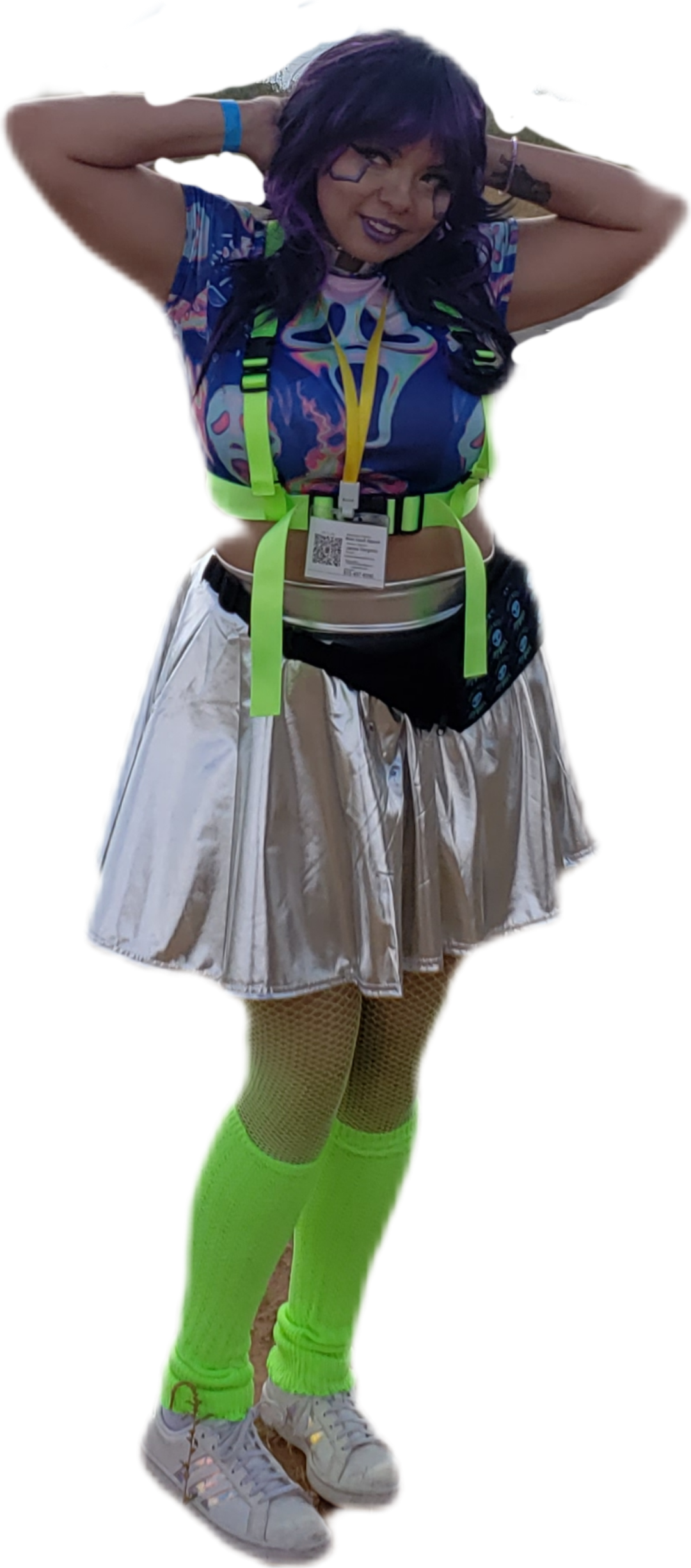The term "Manic Pixie Dream Girl" has been a subject of debate in the world of cinema and pop culture for years. It describes a specific type of female character that has become both celebrated and criticized. As a cultural archetype, the Manic Pixie Dream Girl plays a unique role in storytelling, but what exactly does this term mean? In this article, we will delve deep into the origins, characteristics, and impact of the Manic Pixie Dream Girl on modern media.
Understanding the Manic Pixie Dream Girl goes beyond just recognizing a trope in movies. It involves exploring how society perceives women and their roles in narratives. This article will provide a detailed analysis of the concept, its evolution, and why it matters in today's cultural landscape.
By the end of this guide, you will have a clear understanding of the Manic Pixie Dream Girl and its implications. Let's begin our journey into the world of pop culture and discover why this term continues to spark conversations worldwide.
Read also:Antonio Tejafo The Rising Star In The Football World
Table of Contents
- The Origin of the Term "Manic Pixie Dream Girl"
- Key Characteristics of a Manic Pixie Dream Girl
- Famous Examples of Manic Pixie Dream Girls in Movies
- Criticism of the Manic Pixie Dream Girl Trope
- The Evolution of the Manic Pixie Dream Girl
- Impact on Modern Media and Society
- Psychological Insights Behind the Trope
- Alternatives to the Manic Pixie Dream Girl
- Feminism and the Manic Pixie Dream Girl
- Conclusion: Why Does the Manic Pixie Dream Girl Matter?
The Origin of the Term "Manic Pixie Dream Girl"
The term "Manic Pixie Dream Girl" was first coined by film critic Nathan Rabin in 2007. Rabin used the phrase to describe a recurring trope in romantic comedies and dramas, where a quirky, free-spirited female character exists primarily to inspire and transform the male protagonist. This character is often portrayed as whimsical, unpredictable, and overly idealistic.
Rabin's critique highlighted how these characters are often one-dimensional, serving as plot devices rather than fully developed individuals. The term quickly gained traction, becoming a widely recognized concept in discussions about representation in media.
Why Was the Term Created?
The creation of the term was a response to the lack of depth in female characters within certain genres. By labeling this trope, critics hoped to bring attention to the problematic nature of such portrayals and encourage more nuanced storytelling.
Key Characteristics of a Manic Pixie Dream Girl
The Manic Pixie Dream Girl is defined by a set of distinctive traits that make her easily identifiable in films and television shows. Below are some of the key characteristics:
- Quirky and Unpredictable: She often exhibits eccentric behaviors that set her apart from other characters.
- Free-Spirited: Her love for adventure and spontaneity is a central aspect of her personality.
- Idealistic: She tends to have a childlike view of the world, often ignoring harsh realities.
- Exists for the Male Protagonist: Her primary purpose is to inspire and transform the male lead, usually helping him find happiness or meaning in life.
How These Characteristics Manifest in Stories
These traits are often exaggerated to the point where the character becomes more of a caricature than a realistic person. This lack of complexity contributes to the criticism surrounding the trope.
Famous Examples of Manic Pixie Dream Girls in Movies
Several iconic films feature characters that fit the Manic Pixie Dream Girl archetype. Some notable examples include:
Read also:Discover The World Of Syedot Asmr Your Ultimate Guide
- Samantha from "Sex and the City": Known for her wild personality and bold lifestyle choices.
- Margot Tenenbaum from "The Royal Tenenbaums": A complex character with a touch of whimsy.
- Summer from "500 Days of Summer": Although the film subverts the trope, Summer initially fits the mold.
Why These Characters Resonate with Audiences
Despite the criticism, these characters often resonate with audiences due to their charm and the sense of escapism they provide. However, this appeal can sometimes overshadow the lack of depth in their portrayal.
Criticism of the Manic Pixie Dream Girl Trope
The Manic Pixie Dream Girl trope has faced significant criticism for perpetuating harmful stereotypes about women. Critics argue that these characters reduce women to mere plot devices, denying them agency and complexity. This portrayal reinforces outdated gender norms and limits the diversity of female representation in media.
Common Criticisms
- Lack of Depth: These characters are often one-dimensional, lacking realistic motivations or flaws.
- Objectification: They exist solely to serve the male protagonist's journey, reducing their value as individuals.
- Unrealistic Expectations: Their idealized traits can create unrealistic expectations for both men and women in real life.
The Evolution of the Manic Pixie Dream Girl
Over time, the Manic Pixie Dream Girl trope has evolved in response to changing cultural attitudes. Filmmakers and writers have begun to challenge and subvert the archetype, creating more nuanced and realistic female characters. This shift reflects a growing awareness of the importance of diverse representation in media.
Modern Interpretations
Recent films and television shows have introduced characters that break away from the traditional Manic Pixie Dream Girl mold. These characters are more complex, with their own goals, struggles, and flaws, offering a more authentic representation of women in media.
Impact on Modern Media and Society
The influence of the Manic Pixie Dream Girl extends beyond the realm of entertainment. It reflects broader societal attitudes towards women and their roles in narratives. By examining this trope, we can gain insights into how media shapes our perceptions and expectations.
How Media Shapes Perception
Media plays a crucial role in shaping cultural norms and values. The portrayal of women in films and television can either reinforce or challenge existing stereotypes, making it essential to critically evaluate these representations.
Psychological Insights Behind the Trope
From a psychological perspective, the Manic Pixie Dream Girl can be seen as a manifestation of societal desires and fears. Her idealized traits reflect a longing for simplicity and escapism, while her lack of depth highlights a fear of confronting complex realities.
Why We Are Drawn to These Characters
Humans are naturally drawn to characters that offer a sense of wonder and excitement. The Manic Pixie Dream Girl taps into this desire, providing a temporary escape from the complexities of real life.
Alternatives to the Manic Pixie Dream Girl
As awareness of the trope grows, filmmakers and writers are exploring alternative ways to portray female characters. By focusing on authenticity and diversity, they are creating characters that challenge traditional stereotypes and offer new perspectives.
Examples of Nuanced Female Characters
- Ellen Ripley from "Alien": A strong, independent character with clear motivations and agency.
- Offred from "The Handmaid's Tale": A complex character navigating a dystopian world with resilience and determination.
- Daenerys Targaryen from "Game of Thrones": A multifaceted character with her own ambitions and challenges.
Feminism and the Manic Pixie Dream Girl
Feminist critiques of the Manic Pixie Dream Girl focus on the importance of representation and equality in media. By challenging traditional gender roles and stereotypes, feminism advocates for more diverse and authentic portrayals of women in storytelling.
Why Feminism Matters in Media
Media representation is a powerful tool in shaping societal attitudes towards gender equality. By promoting diverse and realistic portrayals of women, we can work towards a more inclusive and equitable world.
Conclusion: Why Does the Manic Pixie Dream Girl Matter?
The Manic Pixie Dream Girl remains a relevant topic in discussions about representation and storytelling. While the trope has faced criticism for its limitations, it also serves as a reminder of the importance of diverse and authentic portrayals in media. By challenging traditional stereotypes and embracing complexity, we can create narratives that reflect the richness and diversity of human experience.
We invite you to join the conversation by sharing your thoughts and experiences in the comments below. Explore our other articles for more insights into pop culture and media representation. Together, let's continue to push for a more inclusive and equitable world in both fiction and reality.


